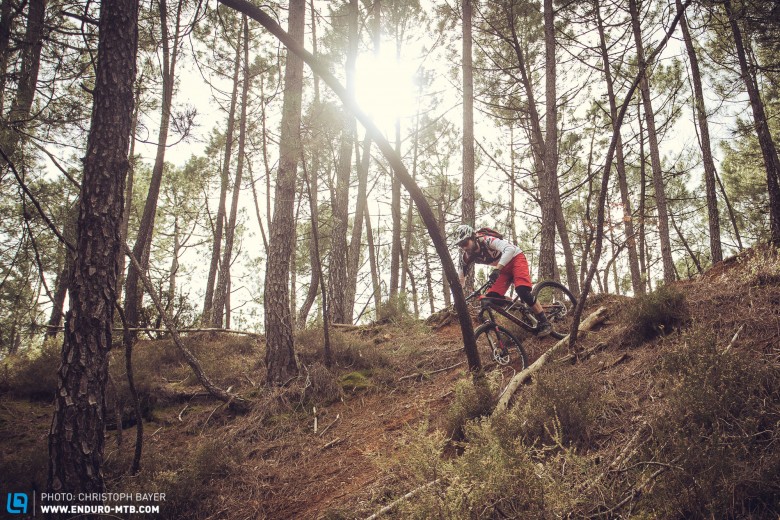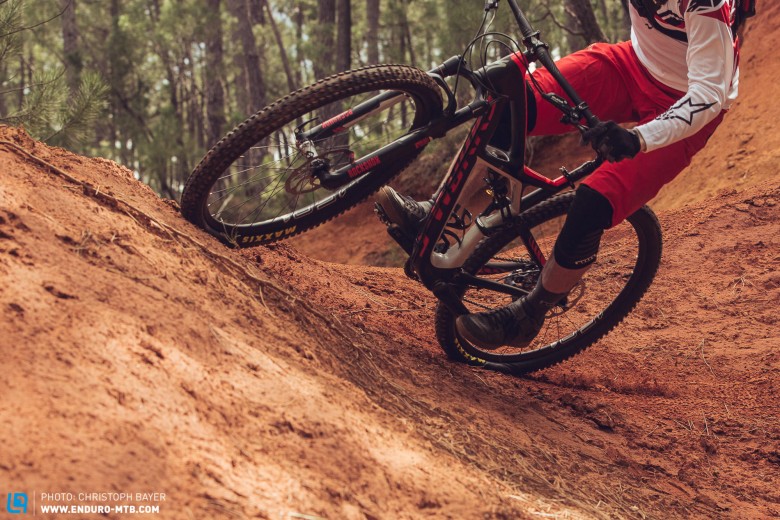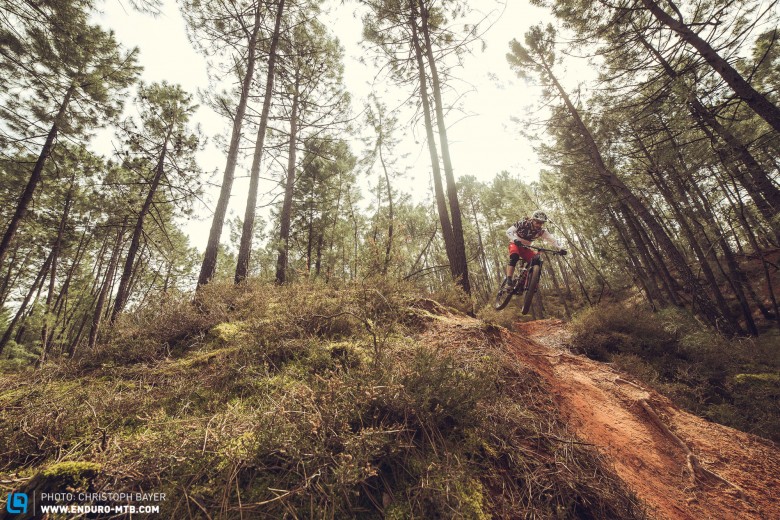Exclusive | First Ride: Specialized Enduro with 6Fattie 27.5+ tyres

Will everyone really be riding plus bikes next year?! Even if we are loath to admit it, this article might be worth reading as there’s a lot of truth in it! Our first exclusive tests, carried out in the South of France, uncovered some decisive advantages when it came to riding and racing on plus-size tyres. Benefits, you ask? What are those and what can still be done? Read here.

In the first part of this series we outlined the theoretical advantages of plus-size tyres, and this new trend in general,. Now we’re talking about their actual performance on the trail. To allow us to get hard facts about the riding differences between the plus-size prototype and regular 29” tyres, we used a slo-mo camera to capture the 3” Specialized 6 Fattie tyres against our control tyres, the 29 x 2.4” Maxxis Minion DHF.

The test build / The test candidate
At the time of testing, the Specialized Ground Control 6 Fattie tyres had already begun to take shape as an advanced prototype. Measuring 27.5 x 3.0”, Specialized recommends running a max pressure of 1.5 bar. Varying their pressure from 0.9 to 1.2 bar (13 to 17 PSI), we ran the tyres on 27.5” Specialized Roval Traverse SL Fattie wheels which have a 30mm width (inner rim).
The small-knobby profile of the Ground Control’s tread is very symmetrical and flat, with well-spaced knobs. The alternative mid-profile, the well supported shoulder lugs and the smaller ones in between create a flat and gap-free profile. One particular standout feature of these tyres is the significant change in height between the middle and the edge of the tread. Given the low recommended pressure (0.9-1.1 bar), this isn’t actually surprising, when you consider that a big-volume tyre with a low pressure acts completely differently to a small-volume, high-pressure one. And that’s exactly where that huge advantage, which you’ll read about in our test report, comes from.

The test
We’ve split our findings into what really counts when it comes to tyres. After all, it’s the interplay of all these factors that determine how they roll.
Video Comparison
Traction: Given the larger surface area, which grip better due to the low air pressure, the tyres offer considerably more traction on steep climbs as well as on loose terrain. On steep or bermed corners the tyre breaked out far later than our 29” control one, despite its small-knobby profile. In extreme situations like these, the greater surface area is a definite advantage, with massive plus points for stability and control. But that’s not the only advantage: the fact that the tyres cling to the ground and iron out all its minor bumps, you’re destined to have a comfier ride on rough terrain with more traction.

Precision: A characteristic that’s majorly impacted by big-volume tyres, you might notice some disadvantages here. Particularly when riding on fast, hard ground, you’ll see a decrease in steering precision and undefined handling as the big-volume means they tend to be a little squidgy. The low pressure is noticeable again on compressions and drops, as the tyre begins to spread and you lose both energy and ground feeling. This is the reason why we quickly raised the pressure up to 1.2 bar (with a rider weight 75kg) in increments of 0.1 bar from the 0.9 bar we began with. The 0.3 bar that we added made a significant difference and led to much more precise handling when it came to the tyre’s grip threshold.

As we mentioned above, the wider tyres suck up bumps like a first-rate Dyson, which makes them an even more crucial part of the bike than normal – that’s why it’s super important in the name of precision that the combination of tyre pressure and suspension is in harmony. With too little pressure, the tyre’s going to squish (impacting on precision) before the suspension is even able to do its duty and soak up the bumps. During our tests, the 1.2 bar (17 PSI) air pressure was sufficient in achieving the correct balance with the compression damping setting of the suspension.
Inbuilt damping: It’s also vital that the tyres don’t ‘give’ at high speeds or begin to jump over big bumps (the so-called bouncy ball effect). Our first tests (thankfully) delivered a good impression. On climbs, you do notice a little more speed wobble due to the big volume, but these Specialized tyres descend peacefully, keeping close to the ground. Rocky sections saw the tyres lose a little tracking accuracy, but the inbuilt damping is at a pretty decent level overall and makes sure that the tyres aren’t overly jumpy.
Threshold: In general, we’d say that the consequence of having big volume tyres is a reduction in ground feedback, meaning you’ll have to get used to a more undefined grip threshold. This isn’t necessarily a negative thing – you could swap the word ‘undefined’ for ‘forgiving.’ And at the end of the day, it’s the rider’s own preference that reigns here. In reality, many riders would opt for an undefined yet forgiving threshold over a digitalized ‘on-off’ sort of behaviour that regular tyres offer.

Rolling resistance: As we’ve already said, the plus-size tyres roll extremely well over small and large bumps and obstacles without forcing you to exert too much energy, and this applies to both hard-packed and loose ground. On hard-packed ground the conventional 29” tyres with 1.6 bar (23 PSI) felt significantly faster.
Weight and handling: Weighing around 500 grams more than the 29” control wheels (DT Swiss XM 1501 Spline ONE and tubeless Maxxis Minion DHF tyres) and with a 4 cm smaller circumference (27.5+: 230.3 cm / 29”: 234.2 cm), the stats testify to the results in this category: the new 27.5+ tyres aren’t what you’d define as dynamic and agile.
Happy ending?
At this stage it’s too early to pass a definitive judgement. The test tyres are still in the prototype stage and we don’t want to compare apples with oranges. The first impressions do show enormous potential for plus-size tyres – but potential in this case still means there are challenges ahead.
Frame requirements: Given the larger sizes, bike designs will need to be adapted or perhaps we’ll even see new designs entirely. The measurements and parametres will have to be altered to fit these new plus-size tyres.
For dealers and customers the variety of options, standards and philosophies will potentially result in confusion, nervous wringing of hands and higher costs, be it from increased storage costs or because you’ve realized you’ll soon need a new bike.
Plus tyre system: To minimise the disadvantages of the bigger tyres it’s insufficient to just make them lighter. On the contrary, we need to look at how the lighter volumes can maintain better form and be more stable. A wider rim is potentially an effective part in this case. But the question remains: how much does the rim width affect a tyre’s performance? How stable does a wheel need to be for a big volume tyre with great traction and therefore more power? What size width makes the most sense and which would provide the ideal bond for rim and tyre width? Now it’s certainly the case that cohesive tyre-wheel combos make more sense than ever.

Who are plus tyres suited for? Right now, plus tyres work in the advantage of long-day and less aggressive riders, who’ll profit from the significant boost in grip and stability. When it comes to racing, we’ll have to wait and see what technical developments arise in the future. Things like acceleration, precision, efficiency and give need to be optimized before they’re race-ready. A plus tyre needs to at least boast equal puncture resistance (super important for racers), and this is going to prove incredibly challenging to manufacturers.
However, having said this, there is a limited choice of 27.5+ tyres for race use already on the market.

Conclusion: Plus tyres are a reality and will rapidly make their presence known – at the next trade fair probably! The first impression of the Specialized 6Fattie 27.5+ are really positive and present noticeable plus-points for touring riders. But the new plus tyres do still demand more development, in particular in combination with wheel technology, in order to reduce the current weaknesses.
Unfortunately this current trend means that dealers, customers – and manufacturers to some extent – are going to be left with a flurry of questions, insecurities and frustrations. We believe in the benefits of this new trend – but not in its current form.
“Those presumed dead live longest” – find out next week what we mean by this!
Words: Robin Schmitt | Photos: Christoph Bayer
Did you enjoy this article? If so, we would be stoked if you decide to support us with a monthly contribution. By becoming a supporter of ENDURO, you will help secure a sustainable future for high-quality mountain bike journalism. Click here to learn more.








